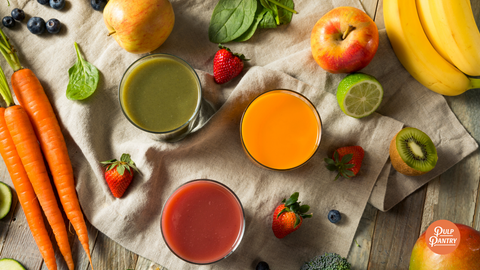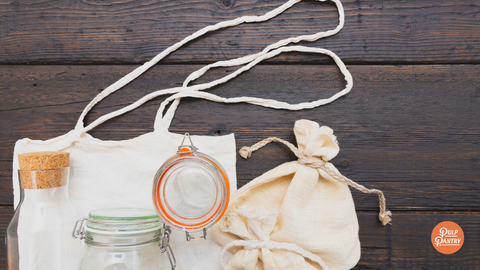
Hey there, we're Pulp Pantry, and we're pulp-obsessed. Today, we're breaking it down with our favorite reasons to fall in love with your juice's other half.
But first, what is pulp? Pulp is the fibrous byproduct leftover after extracting the juice from fresh fruits and vegetables. Technically, it’s called pomace. Personally, we like to call it pulp ☺︎ ♥︎.

How much pulp is out there?
Our sourcing partners produce a lot of juice, but what’s left behind is 15% to 50% of the original vegetable - in the form of fibrous pulp. Generally, the juicier, thicker the vegetable, the more juice you’ll yield. Juicier vegetables like cucumbers might yield 80% or more juice. Leafy greens like kale might yield around 50% juice. I’m sure you’ve noticed this if you juice at home! You might be shocked by how much pulp you’re left with when you juice certain fruits and veggies, but not others.
Our cold-pressed juice partners have millions of pounds (!!!) of pulp that they produce each year, and they’re challenged to figure out sustainable solutions for exactly how to manage such a huge volume of byproduct.
We created Pulp Pantry as a food waste solution, believing that no good food should go waste. Especially fresh fruits and veggies!

What do companies currently do with their pulp?
Some companies pay millions of dollars in hauling contracts to compost their pulp, others admit they have no choice but to landfill (especially in cities like Los Angeles!). Some are lucky to find farmers locally that can pick up pulp for animal feed. No matter what food waste solution is currently in place, our partners are excited about working to turn high quality, organic produce back into high-value items that feed people first. Working to upcycle nutritious juice pulp into delicious snacks is a win for our supplier partners, a win for us, a win for the planet, and a win for you.
Our Pulp Chips are made out of celery and kale fiber and 50% total upcycled ingredients. By incorporating fresh ingredients to make better-for-you snack staples, we’re able to keep good food out of landfills while squeezing 4-5g of fiber in each ounce serving of chips (a bag is nearly your full day’s serving of fiber). It all makes the juice well worth the squeeze, am I right?

Why shouldn’t we throw pulp away?
Pulp contains nearly 95% of the fiber of fresh fruits and veggies, as well as up to half the nutrients. They’re the very same things that we are urged to eat more of to reduce the risk for everything from type 2 diabetes and obesity to cardiovascular disease and cancer. Today, only 1 in 10 Americans gets their servings of fruits, vegetables and fiber, with significant implications for our health and wellbeing.

If everyone were to eat their servings of fresh fruits and veg, we’d save over 100,000 lives and $17 billion dollars in medical costs. The Union of Concerned Scientists also reports that if Americans ate the recommended amount of fruits and vegetables, the increase in longevity would save our economy over $11 trillion.
Yet across the United States, fruits and vegetables are the number one wasted item, making up thirty-nine percent of total food waste. In landfills, fruit and veggie waste creates methane, a potent greenhouse gas. We’re crazy to be throwing out the ingredient we most need in our diet! We’ve already explored how food waste can be extremely detrimental to our environment, exacerbating climate change, here.

What are the benefits of pulp? Is pulp good for you?
The answer is yes! Here’s why pulp contains nutrition that shouldn’t be left behind:
1. Pulp is rich in fiber.
Pulp contains nearly 95% of the fiber of fresh fruits and vegetables after they’re juiced (an analysis I conducted comparing a whole vegetable’s fiber content to its juice counterpart on the USDA database).
Fiber helps regulate the body’s use of sugars, helping to keep hunger and blood sugar in check. We need at least 20 to 30 grams of fiber per day for good health, but most of us average about 15 grams a day. By using pulp as an ingredient to make delicious, convenient snacks like Pulp Chips, we can help bridge the gap between our current fiber intake and the amount we really should be eating.
A little refresh: why is fiber good for you?
Research shows that a lack of fiber causes inflammation in our gut -- and throughout our body. Increased fiber intake is linked to a lower incidence of cardiovascular disease and obesity. The benefits of fiber (and pulp!) are related to the way that fiber feeds our gut microbiome, full of billions of bacteria cells that help us to digest food. Keeping them happy helps our intestines and immune systems thrive. Fiber can help to lower inflammation while helping in the treatment of immune disorders such as inflammatory bowel disease.

- Gut Health is Mental Health
Increasingly, there’s research to show the gut-brain connection. When our gut bacteria are happy, our mood is elevated. Some studies are beginning to show that a healthy microbiome can even lead to reduced instances of depression.
- Other Nutrition Left in Pulp
Fresh fruit and vegetable pulp does contain a good deal of additional vitamins and minerals, polyphenols and carotenoids, but this all varies by the produce item.
What kind of food can you make from Pulp at home? How do you make Pulp snacks? Does pulp taste good?
Pulp is our favorite ingredient, ever. That's why it's the number one ingredient in our Pulp Chips - made from a mix of organic kale and celery juice pulp. In certain countries, like India, people actually add pulp to juices because culturally, they love the texture. Marketing campaigns advertise “pulp in every gulp!”! In the United States, we’ve been a little bit more averse to the texture of pulp in our drinks.

We recreate a ton of traditional recipes by swapping pulp in where fresh veggies are called for. Think of pulp as you do your typical veg ingredient -- it’s just been pre-cut and chopped for you!
Visit our favorite juice pulp recipes here.
In light of food waste becoming a global issue (food waste is the top priority to fight climate change NOW by Project Drawdown), it’s time we start embracing pulp and other fruit and vegetable byproducts, both at home and commercially. At Pulp Pantry, we take vegetable fiber sourced from our cold-pressed juice partners to create traditional snack staples, reinvented with fresh vegetables as the first ingredient.
Anything else you want to know about pulp? Do you have a go-to recipe? Send us a note! hello@pulppantry.com or message us on Instagram or Facebook.

About Pulp Pantry:
Pulp Pantry turns overlooked resources like upcycled vegetable juice pulp into wholesome everyday snacks that make it convenient and delicious to eat more servings of vegetables and fiber.
Our newly launched Pulp Chips are vegetable-based, tortilla style chips made from fresh, upcycled vegetables as the first ingredient. Pulp Chips are a craveable better-for-you, better-for-the-planet snack with up to a full day's serving of fiber in each bag.






